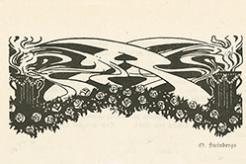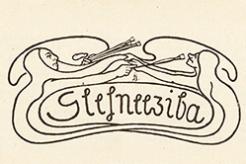




Author: Aija Taimiņa, Dr. philol.
Assessing turn of the century books in Latvia, one has to conclude that aesthetic principles of the “new art” influenced book design to the greatest extent. A series of vignettes and cover sketches by the first Latvian professional artists has become a trademark of Latvia’s Art Nouveau with lasting and internationally recognised value. Most expressive works are typified by imagery rooted in the national worldview and ethnography realised within the form of new art. Book art and typography became quick and effective manifestations of the qualitative changes incited by the “new art”.
The new trends associated with Art Nouveau fostered the popularity of the artistically comprehensive book. Because of this some publications featured Art Nouveau finish as late as in 1912–1914.
Riga’s German publishers were the first to familiarise their readership in Latvia with Art Nouveau, as they printed periodicals and books in both German and Latvian.
The overall scene of publishing and trends of book art at the turn of the century can be understood and evaluated only if Latvia’s and Latvian book art is seen in the context of Germany’s situation in art and publishing. The close cultural and historical links with Germany’s topical artistic phenomena (especially in the fields of graphic art, applied arts, typography and crafts) created preconditions for a gradual transfer and adaptation of new ideas and new principles of book decoration in Latvia.
Arts and Crafts movement that emerged in England in the second half of the 19th century triumphed in Germany on the threshold of the new century, as Richard Wagner’s principle of Gesamtkunstwerk (total artwork) had already prepared the way for the new style of art and life. The “new art” refashioned the foundations of applied arts and everyday culture, aiming to create artworks in which the idea would be harmonised with the execution with particular regard to applied arts as part of the daily life and the basis of culture. The principle of total artwork transformed and consolidated also the inner and outer finish of the book: illustrations, typography, binding, paper and its colour became parts of a unified ensemble. The new aesthetic requirements especially fostered the cultivation of graphic design, invention of new typefaces and corresponding typographic decorations. The appearance of the book changed rapidly: publishers invited artists to work out sketches for bookbinders and printing houses, and thus the new style influenced original leather bindings intended for craft exhibitions along with mass-produced bindings of cheap books with large print runs.
More information will be available in the virtual exhibition, which will be established till April 2016.